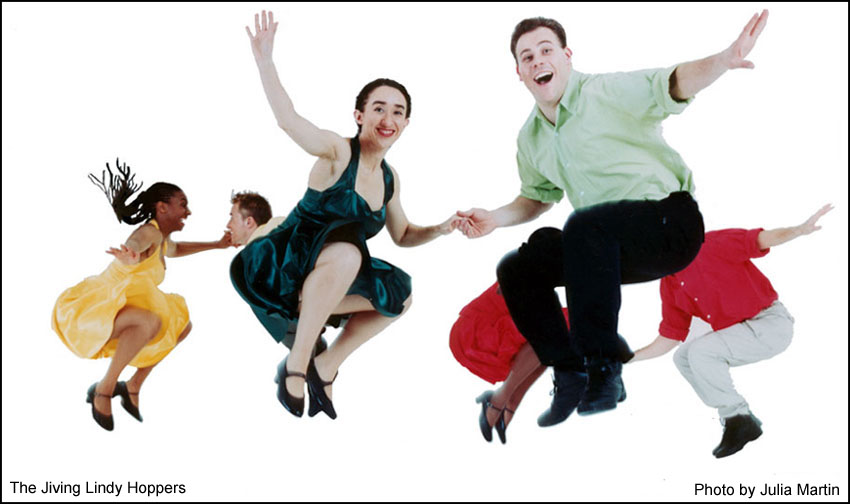
"If you ask ten people what Jive means you will probably get ten different answers!"
People have been Jiving for nearly a hundred years now, and each generation in each country has made this versatile partner dance its own and changed its style to fit the latest music. So, it's not surprising that if you ask ten people what Jive means you will probably get ten different answers! There are perhaps three main threads in the UK at the moment: those who love the music, fashion or style of previous periods and dance a traditional style of jive (which they may call Lindy Hop, Jitterbug, Jive, Rock 'n' Roll or countless other names), those who came to it through Ballroom Dancing and call it The Jive or Ballroom Jive, and those who have gone along to a local dance club where they teach Modern Jive, often known as Ceroc, Le Roc or French Jive. As musical tastes have changed, so too has the style of the dance while retaining its inherent structure and its universal appeal.
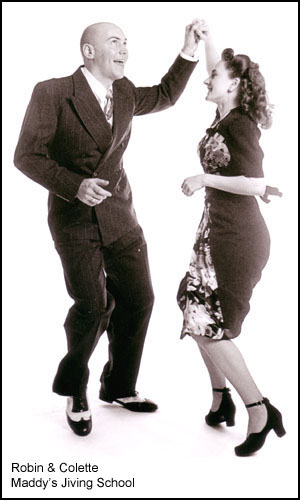
It is usually acknowledged that the grand-daddy of this dance genre was the Lindy Hop - first named as such in 1927. Some histories try to draw direct lines back into the 18th century, but if you are going to do that you might as well go back to the dawn of time, after all he "danced in the morning when the world was begun" and all dance has been related ever since! Like every dance Lindy Hop drew heavily on previous styles, but the combination of elements that made the Lindy Hop unique were the use of both open and closed positions, the use of the open position to allow both partners to improvise, and the syncopation that evolved to fit the latest musical trend: swing.
The dancers at the Savoy in Harlem were mixing dances like the Breakaway and the Charleston to create new styles. The new music told their feet to do triples, so they added triples and Lindy Hop was born with an eight-beat basic foot pattern of 1, 2, 3 & 4, 5, 6, 7 & 8. This new style proved very popular and spread rapidly. The premier dance contest in New York City from 1935 was the annual "Harvest Moon Ball", postponed initially because a crowd of 100,000 gathered and the contestants couldn't get through. In 1935 the categories were Foxtrot, Lindy Hop, Polka, Rumba, Tango and Waltz. In 1942 the name of the Lindy Hop category was changed to "Jitterbug Jive" without any explanation!
"The beginnings of the word ‘jive’ are rather more obscure. It was slang, often associated with Swing music or early jazz."
The name Jitterbug apparently came about in 1934 with Cab Calloway’s band. Trombonist Harry White may have been the first to use the word, describing the dance as "like the frenzy of jittering bugs", then trumpeter Edwin Swayzee wrote a song called "Jitterbug" that became a big hit for Cab Calloway and made "Jitterbug" a household name.
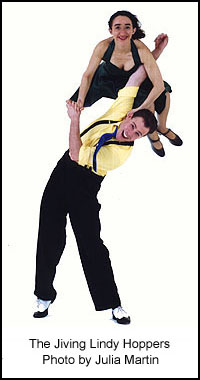
The beginnings of the word "jive" are rather more obscure. It was slang, often associated with swing music or early jazz, and also with imitation, exaggeration, teasing, pretension or glib, foolish talk. It may have come from the English gibe/jibe or the West African jev - we'll never know. Why the word was associated with the dance is also unclear; perhaps because someone said "they’re just jiving" (meaning they were just fooling around), and it was mistakenly taken to mean the actual name of the dance. Cab Calloway made the word more widely known and associated it even more firmly with swing when he published the first-ever dictionary of African-American slang, The New Cab Calloway's Hepsters Dictionary: The Language of Jive, in 1938.
Throughout the 1930s Lindy/Jitterbug expanded and developed into many different styles, adding six-beat patterns and adapting to different styles and speeds of music. According to their personal predilections, dancers incorporated tap and jazz steps, or a smoother style, or added acrobatics and aerials. Frankie Manning (who carried on dancing into his nineties!) is credited with the first air step - flipping a girl over his back in 1936 to win a competition. Films of the period like A Day At The Races and Hellzapoppin' include amazing Lindy performances. There doesn't appear to have ever been a clear distinction between Lindy Hop and Jitterbug, though perhaps the Jitterbug was based more on six-beat patterns than Lindy was.
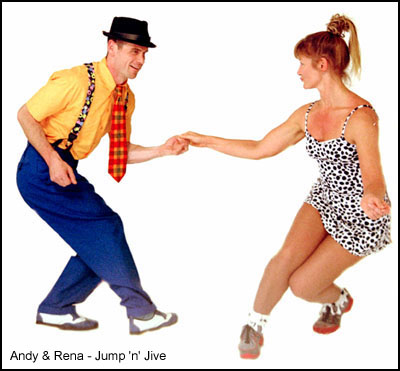
The 1940s brought lots of change. Even though dedicated dancers had already introduced these new American dances into Europe in the 1930s, the influx of American GIs during World War II was the first time most Europeans had seen them. Jive (as it became known in the UK) quickly became enormously popular in the dance halls of the day. Whereas Lindy Hop had started as an eight-beat dance, which quickly acquired six-beat and other patterns, the style that developed in the 1940s in the UK was simpler, tending to use six-beat or four-beat patterns with less innovation, more repetition and lots of spins for the lady.
At the same time in the US, the dance was also continuing to evolve in many directions, depending on the region, the dancers and the music, both informally in the dance halls and formally in the dance schools. 1956 brought another change of name. In the film Rock Around The Clock, featuring Bill Haley's hit record of the same name, one of the dancers, when asked, says that they are dancing "Rock 'n' Roll" even though the dancers were just doing a standard Jitterbug. Europeans liked the name and continue to use it today. As with all dances it spawned different versions in different places. In the UK it became a relatively simple, mainly self-taught, four-beat form of Jitterbug, with the man tending to stay on the spot and letting the lady show off, while in Germany and France it developed into a very acrobatic competitive style. As the music changed, from the syncopated big band swing music to the steady rock 'n' roll beat, so the dance adapted to fit the music of the day.
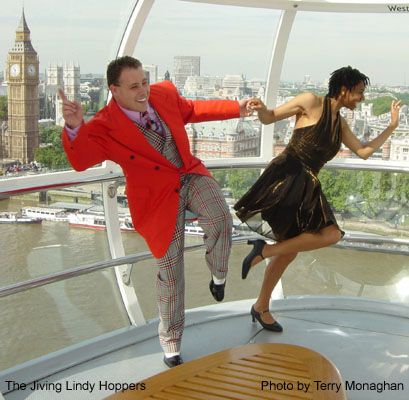
"Jive as a generic term can be applied to any of the dance styles that have developed from Lindy Hop."
So, hopefully you will now understand that "Jive" is a generic term that can be applied to any of the dance styles that have developed from Lindy Hop as music has changed and as dancers have developed new ideas, adopting moves and concepts from other styles - Swing , Boogie-Woogie , B-Bop, Le Bop, Rock 'n' Roll, Hustle, Hollywood Style, West Coast Swing, Push, Whip, Shag, Jitterbug-Jive, Disco-Fox - the list goes on and on - it all depends on where you live and what your favourite dance music is.
Thanks to all these sites that helped me research this article
|
The original version of this article appeared in the September and October 2007 issues of Dance Today, the magazine for social and competitive dancers. This article and the accompanying images are copyright John Sweeney and the acknowledged sources. All rights reserved. No part of this article or these images may be reprinted, stored in a retrieval system, or transmitted in any form or by any means, electronic, mechanical, photocopying, recording or otherwise, without the prior written permission of John Sweeney. |